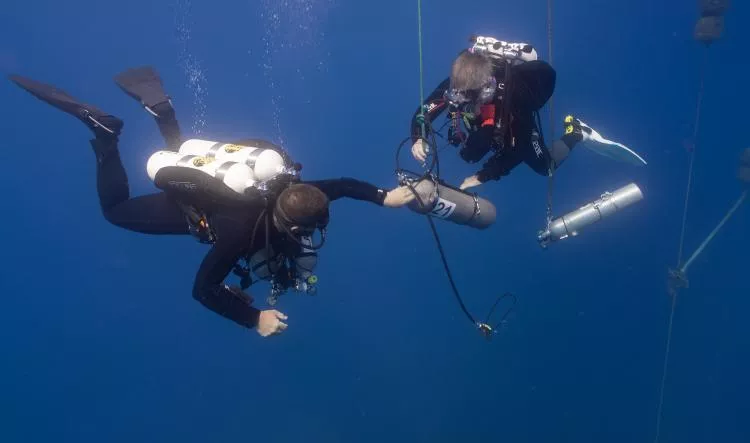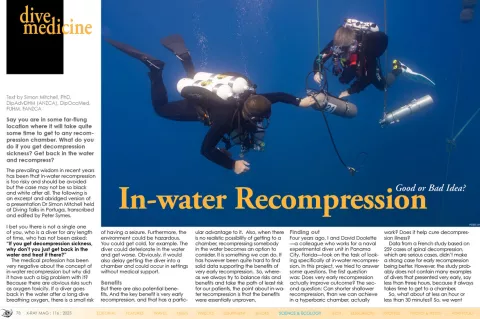Say you are in some far-flung location where it will take quite some time to get to any recompression chamber. What do you do if you get decompression sickness? Get back in the water and recompress?
Contributed by
The prevailing wisdom in recent years has been that in-water recompression is too risky and should be avoided but the case may not be so black and white after all. The following is an excerpt and abridged version of a presentation Dr Simon Mitchell held at Diving Talks in Portugal, transcribed and edited by Peter Symes.
I bet you there is not a single one of you, who is a diver for any length of time, who has not been asked: “If you get decompression sickness, why don’t you just get back in the water and treat it there?”
The medical profession has been very negative about the concept of in-water recompression but why did it have such a big problem with it? Because there are obvious risks such as oxygen toxicity. If a diver goes back in the water after a long dive breathing oxygen, there is a small risk of having a seizure. Furthermore, the environment could be hazardous. You could get cold, for example. The diver could deteriorate in the water and get worse. Obviously, it would also delay getting the diver into a chamber and could occur in settings without medical support.
Benefits
But there are also potential benefits. And the key benefit is very early recompression, and that has a particular advantage to it. Also, when there is no realistic possibility of getting to a chamber, recompressing somebody in the water becomes an option to consider. It is something we can do. It has however been quite hard to find solid data supporting the benefits of very early recompression. So, whereas we always try to balance risks and benefits and take the path of least risk for our patients, the point about in-water recompression is that the benefits were essentially unproven.
Finding out
Four years ago, I and David Doolette —a colleague who works for a naval experimental diver unit in Panama City, Florida—took on the task of looking specifically at in-water recompression. In this project, we tried to answer some questions.
The first question was: Does very early recompression actually improve outcome? The second question: Can shorter shallower recompression, than we can achieve in a hyperbaric chamber, actually work? Does it help cure decompression illness?
Data from a French study based on 259 cases of spinal decompression, which are serious cases, didn’t make a strong case for early recompression being better. However, the study probably does not contain many examples of divers that presented very early, say less than three hours, because it always takes time to get to a chamber.
So, what about at less an hour or less than 30 minutes? So, we went looking for data that answered that question. What if you recompress immediately? The great thing about working with David is that he has access to these big databases of dives, US Navy experimental guys without designing dive tables, and they actually cause decompression sickness in these subjects. But because they are subjects of an experiment, they have a chamber right there. The moment they get symptoms, they go in the chamber—so very early recompression.
We located a data set, but it was in a very obscure publication. It described 166 cases in US Navy experimental dives, with decompression sickness arising in divers after arriving at the surface, and there was little or no delay between symptom occurrence and treatment, as you would expect.
And they showed that 72% of these cases resolved during the compression, not during the entire treatment, but as the chamber was being compressed. So really quickly. Ninety-seven percent resolved during the first recompression, and all of them got better, eventually.
So, does very early recompression improve outcome? I think we can reasonably confidently say, on the basis of hard data, the answer is yes.
Shorter shallower recompression
The second question is, does a shorter shallower recompression work, especially if it is started early?
The standard approach to treating decompression illness in a hyperbaric chamber is the so-called US Navy Table 6 during which 100% oxygen is breathed at the initial depression to 2,8 bar. You cannot do that in the water. It is too dangerous. The risk of oxygen toxicity in the water is way higher than it is in a hyperbaric chamber. The question is, therefore, does something shallower and shorter than that actually work?
I did not know this until David pointed it out, but in the 1960s, when they were developing that table, the US Navy experimented with shallower, shorter recompressions than chambers— but the sort of recompressions you could do in the water.
It is a small data set of just 31 cases of experimental dive decompression sickness that was recompressed to ten metres for 30 minutes and then decompressed over 13 minutes. That was the treatment that divers received. Twenty-five of those recovered completely and two had substantial resolution. And the others needed more treatment. The point is that this very early, short, shallow recompression did work.
Following these findings, the medical community cautiously endorsed in-water recompression, with caveats.
Who to treat in-water
We adopted a grading system for separating our decompression illness into very broad categories and we would treat Tier II- and Tier III-type patients. We would not use in-water recompression for symptoms that are very mild and nonspecific [Tier I]. Someone with Tier II, so-called mild decompression sickness symptoms, or Tier III—the more serious ones with more neurological symptoms are the sort of patients you would consider for in-water recompression.
Chamber proximity
The next question is: Is a recompression chamber close enough that you would not bother with in-water recompression? And somewhat arbitrarily, we chose two hours as the cut-off point. So, if the recompression chamber is more than two hours away you would continue with in-water recompression. If there is a chamber close by, you go to that chamber.
Another question you need to ask: Is the decompression illness stable? If symptoms are progressive, if you follow the rest of these considerations [on the diagram next page], you might default to the end with in-water recompression, even if there is a chamber moderately close by.
Contraindications
Next, consider any contraindications or reasons why in-water recompression cannot be performed.
• Vertigo. Severe vertigo is a contraindication. We don’t want to treat cases with inner ear decompression, in-water, because the patient is just too unwell to go back into the water.
• Oxygen toxicity. If someone was, say, decompressing from a technical dive, had a seizure, came to the surface quickly, and then got decompression sickness, you probably would not want to put them back into the water on oxygen, because they have already had a seizure and their risk might be quite high.
• Incapacitation. If they are so sick or physically incapacitated that returning them to the water would be unsafe, clearly you would not do it. Neither would we take anybody who is unconscious or with a deteriorating level of consciousness into the water.
• Unwilling. The patient has to be willing and want to do it.
The team
Is the team willing, trained and equipped? This is probably the most important question. If you are going to do in-water recompression the following matter is really important.
The patient, the buddy who must accompany at all times, and the surface supervisor must all be trained in decompression procedures or above.
Why? Because they have been taught how to use oxygen safely and what is required to use oxygen in the water. In other words, the patient is an informed risk acceptant, because they understand the risks of using oxygen in the water. The people treating the patient know how to deal with it safely.
In other words, this is not something that your average divemaster can just put up a sign on the side of their dive boat, saying “In-water recompression offered here.” It has to be the right qualified people.
Other requirements
Oxygen. An adequate supply of oxygen is needed. Rebreathers are a very good way of doing that.
Shot line or stage. You should have a shot line or a stage—something that the diver can sit on, be clicked onto, or be supported by. Free swimming during in-water recompression is a big no-no.
Airway protection. And finally, we strongly recommended airway protection of some sort. in case the patient becomes unconscious or has a seizure, one would need to bring them to the surface, but you do not want them to drown while you are doing that. One way of protecting the airway is by using a mouthpiece retainer. It is basically a strap that goes around the back of the head and pulls a flange in around the lips that has the mouthpiece attached to it, and it keeps the mouthpiece in place and helps seal it in the mouth.
Environment
Do you have a suitable environment? What time of day is it? Is the water rough? What is the temperature? Is the diver going to get hypothermia?
Finally, if the answer to [the question] “Do you have a suitable environment?” is yes, then you can go ahead with in-water recompression. I am not going to describe algorithms. There are a bunch of them out there, but look, it can be as simple as what I showed you that the US Navy did in testing for their Table 6: Go down to ten metres, stay there for half an hour, and come back up… go down to ten metres, stay there for an hour, and come back up.
That tends to be what we have done when we have done in-water recompression
We actually codified in-water recompression in a paper, “Decompression sickness and arterial gas embolism,” published in the New England Journal of Medicine.
It basically says: “However, published evidence of the efficacy of short, shallow recompression (at approximately 10m), administered very early, and experience from the 2018 Thailand cave rescue, showing that careful management and use of a full-face mask can protect the airway if a diver becomes unconscious, have provided the basis for qualified endorsement of in-water recompression with the use of oxygen by dives with appropriate equipment and training.”
Conclusions
In-water recompression is endorsed. However, It is not for everyone. It is for people like technical divers who know how to use oxygen safely.
• Short delays to recompression seem associated with better outcomes,
• Recompressions shorter and shallower than the US Navy Table 6 do work, and
• In-water recompression is endorsed by the medical community for divers trained in the use of oxygen underwater and equipped properly for in-water recompression.





























